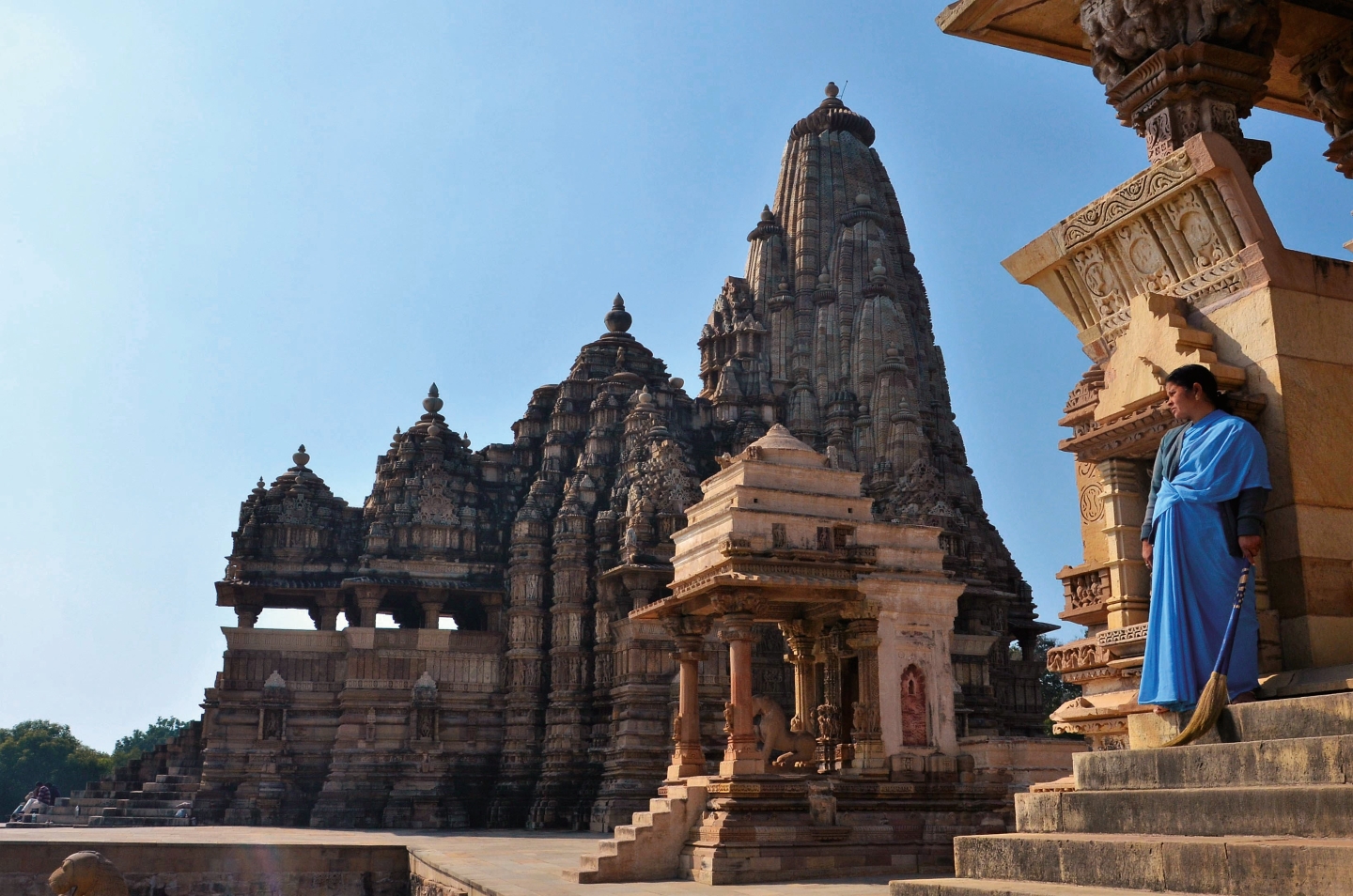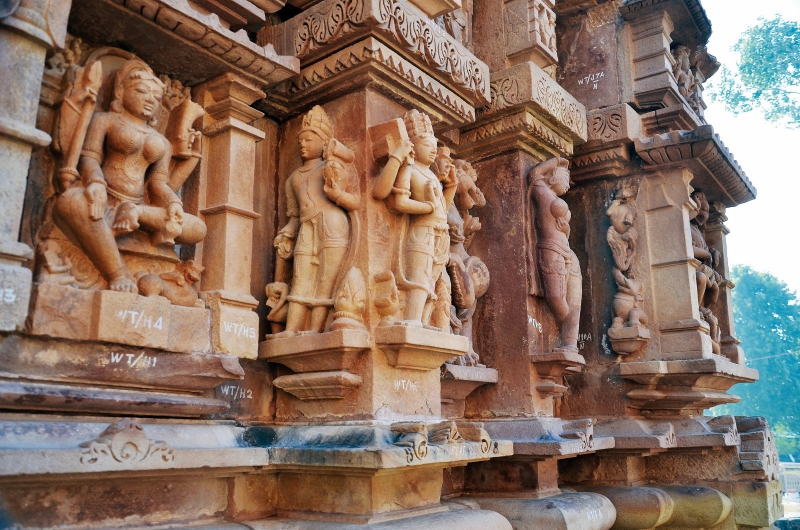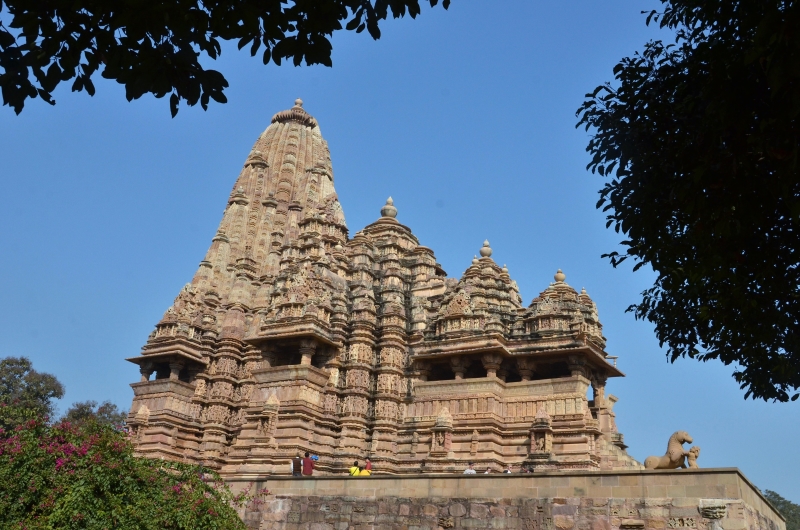
A sweeper stands on the grounds of a temple adjacent to the Kandariya Mahadeva Temple, which displays the multi-tiered architecture and towers (shikaras) typical of Indian temple design (All photos: Lee Yu Kit)
The young woman has her back turned. Her hair is coiffed with a hairband. She wears earrings, a wrist bangle, an armband and a braided waistband. It daringly holds up her scanty garment, which curls around to show her shapely body. She looks suggestively back over her shoulder with a slight coy smile, a look that is as old as she is, which is over 1,000 years old.
She is an apsara, a heavenly nymph who lives with her contemporaries, gods and goddesses, swarming over the exterior of the temples in such exquisite detail and in a state of preservation so that their dress, expressions and fingernails on curved fingers are evident. They live in temples of such stunning beauty and splendid architecture that Unesco had seen fit to grant them World Heritage Site status since 1986, in the remote village of Khajuraho in Chhatarpur district, Madhya Pradesh, India.
The village of just 20,000 people is built around the temple compounds in an embrace, fittingly so, for the villagers depend heavily on these ancient structures for their income. Tourism brings the visitors, the modern and capacious airport, the disproportionate number of hotels, the new train station and the dollars.
In the area, farmers plant mustard and wheat in the fields. In the summer months, it becomes so terribly hot that the villagers abandon their crops, shutter themselves indoors or migrate elsewhere to look for work while visitors stay indoors all day, venturing out only in the late evenings and early mornings when temperatures have receded from nosebleed-inducing highs.
Yet it was here, over 1,000 years ago, that a great kingdom arose. Legend has it that the Moon-God, enamoured by a beautiful damsel, descended to Earth and seduced her. A son was born of the union. His name was Chandravarman, and he founded the Chandela dynasty. During his rule, he dreamt of his mother, who urged him to build temples that would reveal human passions, and in so doing, brought about the realisation of the emptiness of human desire. He started to build the first temples, a tradition his successors would follow.
lakshmanacarving.jpg

The Chandela kings ruled over an area in central India called the Bundelkhand. They were of Rajput descent, and the kingdom flourished from the 9th to the 15th centuries. At the height of their power, they lorded over a large area, not even ceding territory to the notorious Mahmud of Ghazni, who blew in like a bad wind from the north, invading and pillaging parts of the Indian subcontinent repeatedly in the 11th century.
The Chandela kings embarked on a period of frenzied temple building from the 10th and 11th centuries, building 85 great temples in total, of which only 22 have survived to the present day. Although most of the temples are Hindu, Jain temples were also built, acknowledging the importance of the community. There is some evidence, preserved today in the Archaeological Museum in Khajuraho, suggesting Buddhist presence as well.
In later years, the Chandela kings had little time for temple building and maintenance as the kingdom came under repeated attacks and declined, eventually falling under Mughal rule in the 16th century. The Muslim traveller Ibn Battuta, who passed through the area, wrote that a number of yogis, known for their healing abilities, lived in these temples in the 14th century. The area was thickly forested, remote and sparsely populated, sparing the temples from complete destruction, although Muslim invaders passing through the area desecrated many of them.
Over time, the temples were reclaimed by dense forests. Tree roots, vegetation, weather and neglect exacted their toll, and the great temples of Khajuraho faded from view and were forgotten, only to be “rediscovered” in 1838 by a British surveyor.
Although they are long gone, the Chandela kingdom left a magnificent legacy in the temples that grace Khajuraho in three groups today — the Eastern, Western and Southern. Of these, the Western group is the most prominent, rising above the village in a large and verdant park.
tank.jpg

The temples were made from sandstone blocks quarried elsewhere, transported by river and carved under the direction of a master sculptor. The finished stones were brought to the site, where they were assembled using interlocking joints, with no mortar used. This required an exactness of fit that is evident even today in the continuity of the temple structures.
A stone at the apex of a tower (called a shikara) was the crucial keystone or capstone required for the integrity of the whole, keeping it from falling into its constituent pieces. It was the last piece to be placed on the top of the towers. The sandstone edifices were mounted on large bases of basalt stone for stability.
The temples have undergone restoration, some more than others, where the new stone is lighter in colour or where mortar has been applied, but the carvings are original, wearing the scars of damage or chipping.
In the Western group, two of the most prominent temples are the Lakshmana Temple and the Kandariya Mahadeva Temple. Temple building was a serious business — the Vishnu-dedicated Lakshmana temple, built under the orders of King Yashovarman in the 10th century, required the toil of an estimated 20,000 workers working for 20 years to complete.
The nearby Kandariya Mahadeva Temple, dedicated to Shiva, is the largest and tallest, with a height of 31m. Built a century after the Lakshmana temple, it is architecturally the most magnificent.
The structures exhibit the characteristics of classic Hindu temple architecture, distinct from later temples which had strong Mughal influences, and also differing from southern Indian Hindu temples.
kandariya1.jpg

The overall effect resembles several peaks, evoking a range of mountains that culminates in a central grand peak representing Mount Kailash in present-day Tibet. Structurally, there are five main constructs in classical Hindu temple architecture — the entrance, portico, vestibule, religious hall and the sanctum sanctorum, a temple within the temple where the deity occupies the innermost chamber.
The exterior and interior of the temples are richly carved, and herein is a controversial aspect of the Khajuraho temples. Decorated with carved figures of gods and goddesses, apsaras and warriors, scenes of hunting and farming, of women applying make-up and picking thorns from their feet, are the erotic sculptures for which these temples have become notorious.
In fact, the erotic sculptures occupy only about 10% of the temple surface area and they blend into the overall scheme of carved panels. They include couples in various positions and threesomes in lovemaking, with yogi-like acrobatic flexibility. Taken in context, kama or sensual pleasure, is one of the phases of life, like material wealth and dharma (religious duty) leading ultimately to moksha (liberation). Taken out of context, the carvings of sensual pleasure are erotic and explicit. But is the sense of eroticism then in the mind of the beholder, rather than the intention of the sculptor?
The architects, engineers and sculptors who created these temples exhibited a high degree of skill, knowledge and discipline, which is even more remarkable considering their antiquity, but they were human and sometimes indulged in a little quirky humour.
On one of the temples, for example, a row of elephant heads runs around the skirt of the building. Among these, one is different: instead of looking forward, it is smiling and looking to the side, at the adjacent panel of a copulating couple. Similarly, there is a carving of a spectator covering his eyes at a sexual act, but one hand incompletely covers one eye, so that the spectator is peeking. There are similar hidden gems in many of the temples.
parsvnatacarving.jpg

Located a few kilometres away, the Eastern group comprises Jain temples, architecturally similar and as splendid as the Hindu temples but without any erotic carvings or hunting scenes, with statues of the Jain prophets within. Smaller, whitewashed, plain temples in the compound are about a century old, having been rebuilt by the Jain community.
Of the surviving temples of Khajuraho, only one is still active. The Matangesvara Temple is devoid of the exuberant ornamentation and sculptures of the other Khajuraho temples, identifying it as one of the earliest temples. It is of massive proportions, mounted on a lofty stone base with a grand staircase leading up into the temple.
Within lies one of the largest Shiva lingams in northern India. Every evening, a priest rings the bell and performs the Aarti ceremony at the temple. The faithful from the village gather at the base of the temple to observe, chant and pray, as they would have over 1,000 years ago, when the Khajuraho temples were many and unrivalled in their splendour, as they are today.
This article first appeared on June 24, 2024 in The Edge Malaysia.


